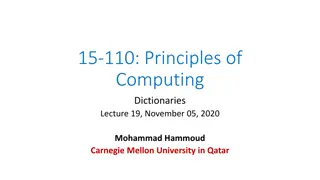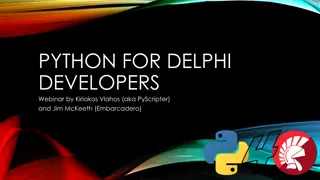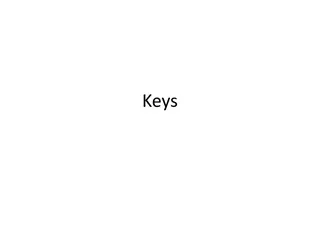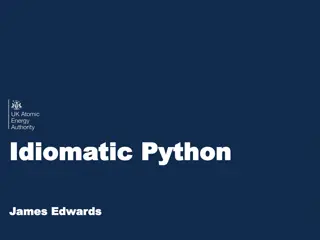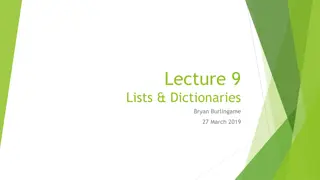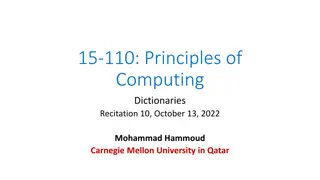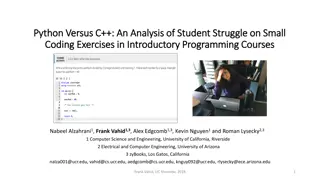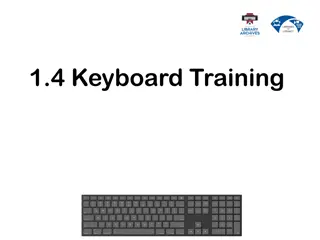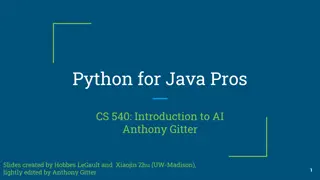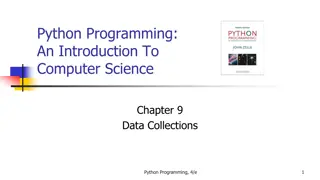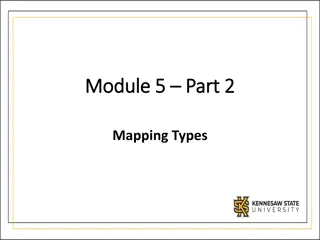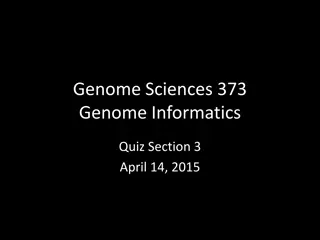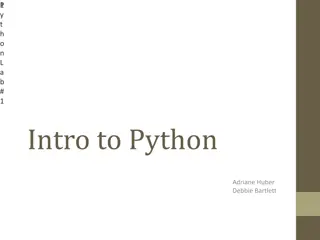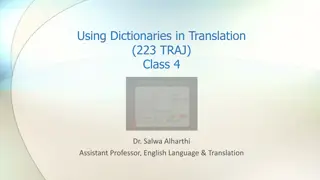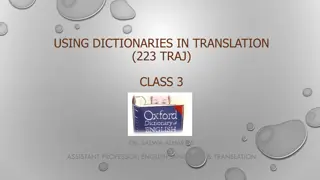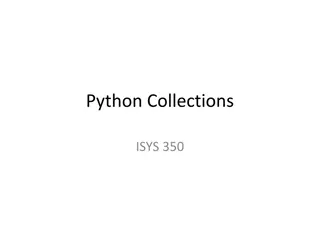Dictionaries in Python: Keys, Values, and Data Structures
Dictionaries in Python are versatile data structures that organize information by association rather than position. With keys pointing to values, dictionaries offer efficient lookups and manipulation capabilities. Learn how to construct dictionaries, access entries, and decide when to use them over lists for optimal data organization.
Download Presentation

Please find below an Image/Link to download the presentation.
The content on the website is provided AS IS for your information and personal use only. It may not be sold, licensed, or shared on other websites without obtaining consent from the author.If you encounter any issues during the download, it is possible that the publisher has removed the file from their server.
You are allowed to download the files provided on this website for personal or commercial use, subject to the condition that they are used lawfully. All files are the property of their respective owners.
The content on the website is provided AS IS for your information and personal use only. It may not be sold, licensed, or shared on other websites without obtaining consent from the author.
E N D
Presentation Transcript
CMSC201 Computer Science I for Majors Lecture 17 Dictionaries Prof. Katherine Gibson Prof. Jeremy Dixon www.umbc.edu Based on slides from http://www.ou.edu/memorylab/python/Lsn15_Tuples.ppt
Last Class We Covered Python s tuple data structure Tuples in functions (and as return values) Basic tuples operations, including Creation Conversion Repetition Slicing Traversing 2 www.umbc.edu
Any Questions from Last Time? www.umbc.edu
Tuple Practice 2 def printall(_____): print (args) What belongs here? printall(1, 2.0, 'three') www.umbc.edu
Tuple Practice 2 def printall(*args): print (args) printall(1, 2.0, 'three') What does this do? www.umbc.edu
Todays Objectives Construct dictionaries and access entries in those dictionaries Use methods to manipulate dictionaries Decide whether a list or a dictionary is an appropriate data structure for a given application www.umbc.edu
Dictionaries A dictionary organizes information by association, not position Example: When you use a dictionary to look up the definition of mammal, you don t start at page 1; instead, you turn directly to the words beginning with M Data structures organized by association are also called tables or association lists In Python, a dictionary associates a set of keys with data values www.umbc.edu
Dictionary Keys In Python, a dictionary is a set of 'keys' (words) all pointing to their own 'values' (meanings). dict1 = {"first_name" : "John", "last_name" : "Cleese"} Dictionary name Key 1 String Value 1 String Key 2 String Value 2 String www.umbc.edu
Dictionaries Keys can be data of any immutable types Including other data structures It is best to think of a dictionary as an unordered set of key: value pairs, with the requirement that the keys are unique (within one dictionary) dict1['John'] = 'Leo' Dictionary name Key 1 String Value 1 String www.umbc.edu
Creating Dictionaries www.umbc.edu
Creating Dictionaries There are three main ways to create a dictionary in Python: 1. Construct a python dictionary (with curly braces syntax) 2. Construct a dictionary from a list (or any iterable data structure) of key, value pairs 3. Construct a dictionary from parallel lists www.umbc.edu
Creating Dictionaries (Curly Braces) The empty dictionary is written as two curly braces containing nothing dict1 = {} To cast a list as a dictionary, you use dict() dict1 = {"fName" : "John", "lName" : "Cleese"} print (dict1) {'lName': 'Cleese', 'fName': 'John } www.umbc.edu From: https://docs.python.org/3.3/tutorial/datastructures.html
Creating Dictionaries dict1 = [('a', 'apple')] print (dict1, type(dict1)) Is this a dictionary? [('a', 'apple')] <class 'list'> Must use curly braces {} to define a dictionary www.umbc.edu
Creating Dictionaries dict2 = {('a', 'apple')} print (dict2, type(dict2)) Is this a dictionary? {('a', 'apple')} <class 'set'> Must use a colon (:) between items, not a comma www.umbc.edu
Creating Dictionaries dict3 = {('a' : 'apple')} print (dict3, type(dict3)) Is this a dictionary? {'a': 'apple'} <class 'dict'> Hooray! www.umbc.edu
Creating a Dictionary eng2sp = dict() print (eng2sp) {} <class 'dict'> What does this output? eng2sp['one'] = 'uno' print (eng2sp) {'one': 'uno'} <class 'dict'> What does this output? eng2sp['two'] = 'dos' print (eng2sp) {'two': 'dos', 'one': 'uno'} <class 'dict'> What does this output? www.umbc.edu
Creating Dictionaries (From List) To cast a list as a dictionary, you use dict() myList = [(5, 'candy'), (15, 'cookies'), (23, 'ice cream')] Must be key pairs myDict = dict(myList) www.umbc.edu From: https://docs.python.org/3.3/tutorial/datastructures.html
Creating Dictionaries (From Parallel Lists) Here we have two parallel lists that we are putting together into a dictionary. names = ["Tina", "Pratik", "Amber"] major = ["Social Work", "Pre-Med", "Art"] major_dict = {} for i in range(len(names)): major_dict[names[i]] = major[i] print (major_dict) {'Pratik': 'Pre-Med', 'Tina': 'Social Work', 'Amber': 'Art'} www.umbc.edu From: https://docs.python.org/3.3/tutorial/datastructures.html
Creating Dictionaries (From Parallel Lists) Rather than using a for loop, there is a built-in function that can put parallel lists together (either into a tuple or dictionary) zip is a built-in function that takes two or more sequences and zips them into a list of tuples, where each tuple contains one element from each sequence www.umbc.edu
Creating Dictionaries (From Parallel Lists) names = ["Tina", "Pratik", "Amber"] major = ["Social Work", "Pre-Med", "Art"] majors_dict = dict(zip(names, major)) print(majors_dict) print(type(majors_dict) What does this output? {'Amber': 'Art', 'Tina': 'Social Work', 'Pratik': 'Pre-Med'} <class 'dict'> www.umbc.edu
Creating Dictionaries One other way to create a dictionary is by using dictionary comprehension dict1 = {x: x**2 for x in (2, 4, 6)} print(dict1) What does this output? {2: 4, 4: 16, 6: 36} www.umbc.edu
Dictionary Operations www.umbc.edu
Dictionary Operations 1. Accessing Values in Dictionary 2. Updating Dictionaries 3. Delete Dictionary Elements www.umbc.edu From: http://www.tutorialspoint.com/python/python_dictionary.htm
Accessing Values in Dictionary To access dictionary elements, you can use the square brackets along with the key to obtain its value dict1 = {'fName': 'Mike', 'lName': 'Jones', 'Age': 18}; print ("dict1['fName']: ", dict1['fName']) print ("dict1['Age']: ", dict1['Age']) dict1['fName']: Mike dict1['Age']: 18 www.umbc.edu
Updating Dictionaries dict1 = {'fName': 'Mike', 'lName': 'Jones', 'Age': 18}; print("Before Update") print("dict1['fName']: ", dict1['fName']) print("dict1['Age']: ", dict1['Age']) New Entry dict1['School']= "UMBC" dict1['Age']= 19 Updated Entry print("After Update") print("dict1['School']: ", dict1['School']) print("dict1['Age']: ", dict1['Age']) www.umbc.edu
Updating Dictionaries Before Update dict1['fName']: Mike dict1['Age']: 18 After Update dict1['School']: UMBC dict1['Age']: 19 www.umbc.edu
Delete Dictionary Elements You can either remove individual dictionary elements or clear the entire contents of a dictionary. You can also delete an entire dictionary in a single operation. www.umbc.edu
Delete Dictionary Elements dict1 = {'fName': 'Mike', 'lName': 'Jones', 'Age': 18}; print("Before Update") print("dict1['fName']: ", dict1['fName']) print("dict1['lName']: ", dict1['lName']) print("dict1['Age']: ", dict1['Age']) del dict1['fName'] # remove entry with key 'Name' #dict1.clear() # remove all entries in dict #del dict1 # delete entire dictionary If we remove, the dictionary, it will cause an error. print("After Update") print("dict1['lName']: ", dict1['lName']) print("dict1['Age']: ", dict1['Age']) www.umbc.edu
Dictionary Functions and Methods www.umbc.edu
Functions and Methods len(dict) str(dict) type(variable) dict.clear() dict.deepcopy() dict.fromkeys() dict.get(key, default=None) dict.items() dict.values() dict.keys() dict.setdefault(key, default=None) dict.update(dict2) www.umbc.edu From: http://www.tutorialspoint.com/python/python_dictionary.htm
Functions len(dict) Gives the total length of the dictionary. This would be equal to the number of items in the dictionary. str(dict) Produces a printable string representation of a dictionary type(variable) Returns the type of the passed variable. If passed variable is dictionary, then it would return a dictionary type. www.umbc.edu From: http://www.tutorialspoint.com/python/python_dictionary.htm
Methods dict.clear() Removes all elements of dictionary dict dict.deepcopy() Returns a deep copy of dictionary dict dict.fromkeys(seq, value=None) Create a new dictionary with keys from seq and values set to value. dict.get(key, default=None) For key key, returns value or default if key not in dictionary www.umbc.edu From: http://www.tutorialspoint.com/python/python_dictionary.htm
Methods dict.items() Returns a list of dict's (key, value) tuple pairs dict.values() Returns a list of dictionary dict's values dict.keys() Returns a list of dictionary dict's keys www.umbc.edu From: http://www.tutorialspoint.com/python/python_dictionary.htm
Methods dict.setdefault(key, default=None) Similar to get(), but will set dict[key]=default if key is not already in dict dict.update(dict2) Adds dictionary dict2's key-values pairs to dict www.umbc.edu From: http://www.tutorialspoint.com/python/python_dictionary.htm
When to Use a Dictionary? You have to retrieve things based on some identifier, like names, addresses, or anything that can be a key. You don't need things to be in order Dictionaries do not normally have any notion of order, so you have to use a list for that You are going to be adding and removing elements and their keys www.umbc.edu From: Fundamentals of Python: From First Programs through Data Structures
Dictionary Examples www.umbc.edu
Example: The Hexadecimal System You can keep a hex-to-binary lookup table to aid in the conversion process hexToBinaryTable = {'0': '0000', '1':'0001', '2':'0010', '3': '0011', '4':'0100', '5':'0101', '6': '0110', '7':'0111', '8':'1000', '9': '1001', 'A':'1010', 'B':'1011', 'C': '1100', 'D':'1101', 'E':'1110', 'F': '1111'} www.umbc.edu From: Fundamentals of Python: From First Programs through Data Structures
Example: The Hexadecimal System You can keep a hex-to-binary lookup table to aid in the conversion process def convert(number, table): binary = '' for digit in number: binary = binary + table[digit] return binary def main(): print(convert("34A", hexToBinaryTable)) print(convert("11C", hexToBinaryTable)) main() 001101001010 000100011100 www.umbc.edu From: Fundamentals of Python: From First Programs through Data Structures
Dictionary Example (Psychotherapist) A doctor in this kind of therapy responds to patient s statements by rephrasing them or indirectly asking for more information For example: Writing a program that emulates a nondirective psychotherapist www.umbc.edu From: Fundamentals of Python: From First Programs through Data Structures
Dictionary Example (Psychotherapist) -bash-4.1$ python psych.py Good morning, I hope you are well today. What can I do for you? >> my dad and I don't like each other You seem to think that your dad and you don't like each other >> my mother and father are mean to each other Why do you say that your mother and father are mean to each other >> I like to eat candy Many of my patients tell me the same thing. www.umbc.edu From: Fundamentals of Python: From First Programs through Data Structures
Dictionary Example (Psychotherapist) When user enters a statement, the program responds in one of two ways: With a randomly chosen hedge, such as Please tell me more By changing some key words in user s input string and appending the string to a randomly chosen qualifier Thus, to My teacher always plays favorites, the program might reply, Why do you say that your teacher always plays favorites? www.umbc.edu From: Fundamentals of Python: From First Programs through Data Structures
Dictionary Example (Psychotherapist) Program consists of a set of collaborating functions that share a common data pool Pseudocode: output a greeting to the patient while user input doesn t equal Quit : prompt for and input a string from the patient if the string does not equal Quit : call another function to obtain a reply to this string output the reply to the patient output a sign-off message to the patient www.umbc.edu From: Fundamentals of Python: From First Programs through Data Structures
Dictionary Example (Psychotherapist) import random hedges = ("Please tell me more.", "Many of my patients tell me the same thing.", "Please continue.") qualifiers = ("Why do you say that ", "You seem to think that ", "Can you explain why ") replacements = {"I":"you", "me":"you", "my":"your", "we":"you", "us":"you", "mine":"yours"} www.umbc.edu From: Fundamentals of Python: From First Programs through Data Structures
Dictionary Example (Psychotherapist) def reply(sentence): probability = random.randint(1,4) if probability == 1: return random.choice(hedges) else: return random.choice(qualifiers) + changePerson(sentence) def changePerson(sentence): words = sentence.split() replyWords = [] for word in words: replyWords.append(replacements.get(word, word)) return " ".join(replyWords) www.umbc.edu From: Fundamentals of Python: From First Programs through Data Structures
Dictionary Example (Psychotherapist) def main(): print("Good morning, I hope you are well today.") print("What can I do for you?") sentence = input("\n>> ") while sentence.upper() != "QUIT": print(reply(sentence)) sentence = input("\n>> ") print ("Have a nice day!") main() www.umbc.edu From: Fundamentals of Python: From First Programs through Data Structures
Dictionary Example (Psychotherapist) Functions in this program can be tested in a bottom-up or a top-down manner Program s replies aren t great when: User addresses the therapist in the second person User uses contractions (for example, I m and I ll) With a little work, you can make the replies more realistic www.umbc.edu
Any Other Questions? www.umbc.edu
Announcements Project 1 is out! Due on Monday, April 18th @ 8:59:59 PM Get started on it now! www.umbc.edu





